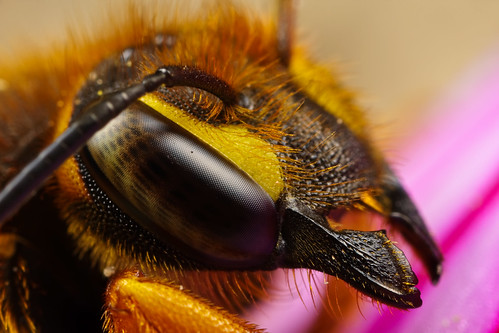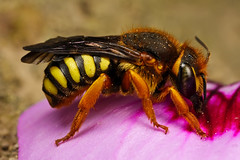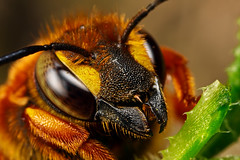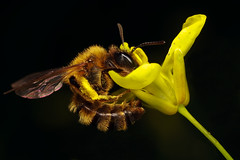This is, I hope, going to be a discussion about diffraction and how the effects of motion blur can be mistaken for it. But before I dive in I need to make a few things clear:
Please do not give me links to your examples of diffraction limited photos -I know that diffraction exists so there is no need to prove it...
Please read this entire post carefully, and with an open mind, before you post a comment...
When I first got into macro three years ago there were two prevailing themes: You had to use a tripod to get sharp images, and diffraction is the primary reason why you can't stop a lens down and get sharp images. I wanted to let the subject dictate how I shot it, and to go after moving targets, so I came up with the
Left Hand Brace Technique for taking control of the motion in a scene so I could get the compositions and sharpness that I was looking for without using a tripod. Along the way I started to realize that what a lot of people were calling diffraction was really nothing more than a form of motion blur that I call macro motion blur. To explain how motion blur can mimic diffraction you first have to really understand what diffraction is.
The classic definition of diffraction is light bending as it passes through a small opening, and that's true. But there's a little more to it than that: The rays of light actually expand, like a cone, so that light rays that should hit a single pixel are now bleeding over into adjacent pixels. When that bleeding over reaches half way into those adjacent pixels you'll see a loss in image quality -diffraction has taken your lunch money.
But if you can wrap your head around expanding light rays causing a loss of detail then couldn't motion blur, as little as half a pixel of movement during the exposure, look like diffraction? My experience has taught me that it can.
Right about now some of you are thinking "But wait a minute Mr. Macro Motion Blur, why do my images get sharper when I decrease my Fstop?!" To answer that question we have to first determine what your real shutter speed is. At macro magnification, high Fstops, and low ISOs, the light that your flash is producing is the only significant light source in a scene. To prove it just set your camera to manual mode, F11, 1/200 of a second (or whatever your maximum flash sync speed is for your camera), ISO 100, and go out and take a photo on a bright sunny day with your macro lens set to its minimum focusing distance (life size magnification). You'll have to shoot something white or yellow to get anything to show up in the resulting image. Then turn on your flash and take the same shot -there will be a major difference in what you can see in the photo. At higher magnifications, with the flash turned off, you'll just get a completely black image. So your flash duration is really your shutter speed, since it's the major, or only, light source -the actual speed of the shutter doesn't matter...
So you set your camera to manual mode, F11, 1/200, and ISO 100. You've got a rig that will let you shoot at 2x, you take a shot hand held, and the resulting photo isn't very sharp. You then set your camera to F8, take the same shot, and this time the image is a lot sharper. See, no more diffraction! Well there's only one little problem -when you went from F11 to F8 you opened up the aperture in your lens to let twice as much light into the camera. Through The Lens (TTL) metering compensated for the increase in aperture (decreasing Fstop) by turning the flash on half as long -so your shutter speed (the flash) doubled. Did you defeat diffraction or macro motion blur?...
For me the answer is simple, since I can get sharp images at life size to three times life size at F13, and four to five times life size at F10 with Canon's MPE-65mm macro lens. The key is to get the flash as close to the subject as possible, use a diffuser that really diffuses the light (not one that just blocks the light), and look for ways to take control of the motion in the scene. Diffraction does exist, but it's not the bogyman that most people make it out to be...








